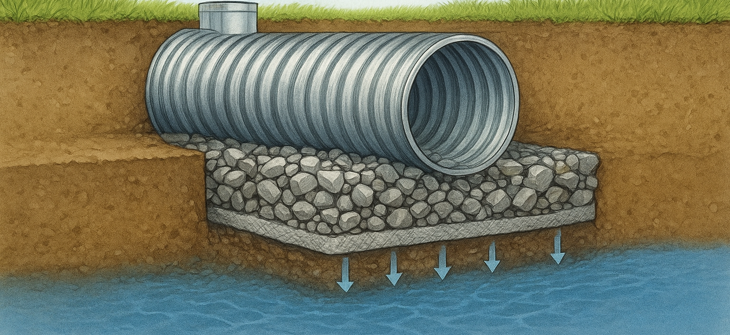
Infiltration Done Right: Best Practices for CMP-Based Stormwater Recharge
Key design strategies for effective CMP stormwater infiltration
Infiltration systems offer a sustainable way to manage stormwater by recharging groundwater rather than discharging runoff. Corrugated metal pipe (CMP) based systems allow this to happen underground, preserving surface space. But infiltration design requires close attention to detail, from soils testing to materials specification.
Verify the Basics
Always start by confirming the infiltration rate with site-specific testing. Regulatory agencies often require that systems empty within 24–72 hours. If infiltration is too slow, a detention system may be a better choice.
Stone Matters
Use clean, angular stone with high void space (typically 37–40%). Rounded or dirty stone reduces both structural support and void capacity. Some agencies apply conservative void assumptions (e.g., 30%) to account for future sediment loading, so designs should error on the side of caution.
Use Geotextile Fabric
Wrapping the system in non-woven geotextile keeps fines out of the stone layer. This is essential for long-term infiltration capacity and should be included around the entire storage zone, not just the bottom. Engineers can add this added protection at their discretion for minimal cost.
Watch the Water Table
Infiltration systems must be above the seasonal high-water table. If shallow groundwater is present, the system may need to be raised or redesigned as watertight detention to prevent flotation and maintain performance.
Get More Out of the Footprint
Increasing the depth of stone above or below the pipe can add storage without expanding system width. This is especially helpful for shallow cover conditions or when space is at a premium. CMP isn’t limited to a few standard sizes, the product can be manufactured in 1” increments if the project size dictates.
CMP infiltration systems offer a powerful blend of performance and flexibility—but only if they’re designed to match site conditions. When done right, they provide reliable, regulatory-compliant performance and long-term groundwater recharge benefits.
